Weekly recap:
US stocks finished last week mixed, with the Dow Jones Industrial Average and the S&P 500 posting modest gains, while the tech-heavy Nasdaq fell for a second straight week. Concerns regarding elevated valuations and increased scrutiny surrounding AI spending drove a rotation away from growth and tech stocks, which had helped propel indices to recent record highs.
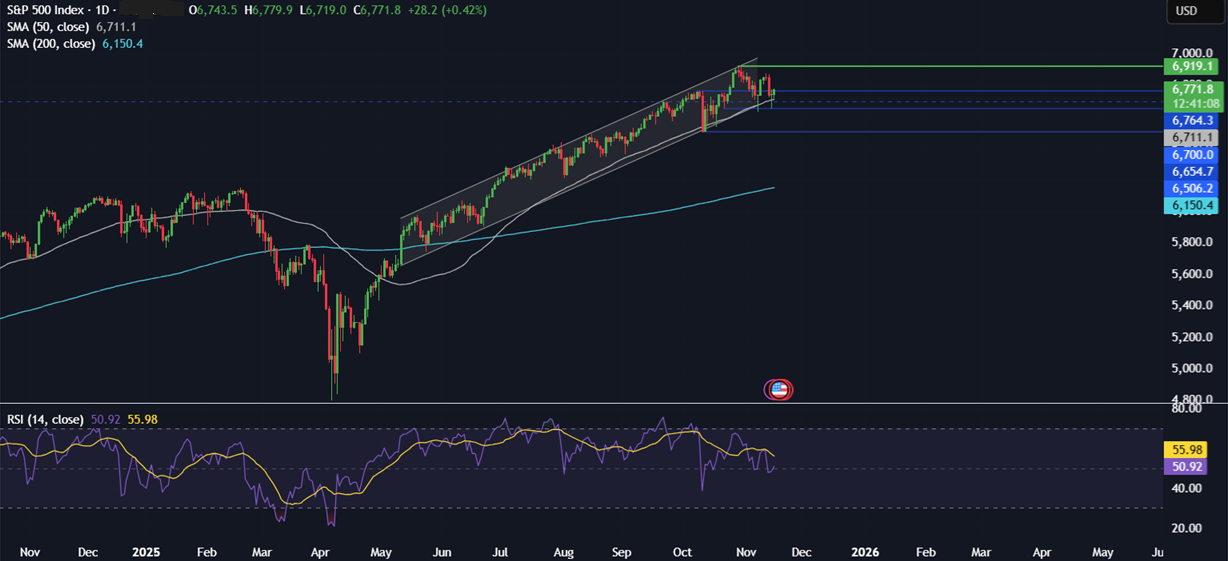
In positive news, the US government reopened after the longest shutdown on record, following President Trump’s signing of a bill to fund the government through January 30. While this has removed a major headwind, stocks fell sharply on Thursday amid questions over when data releases will restart. The White House warned that October inflation and non-farm payroll data may never be released, meaning that the Fed may be flying blind into the December FOMC meeting, hitting risk sentiment. The BLS announced it would release the September jobs report on 20 November.
Cautious Federal Reserve commentary saw the market rein in December rate cut expectations to under 50% from 94% a month ago and 67% a week ago. Even so, Gold still rose 2% across the week. Down from 5% gains earlier in the week. The USD fell across the week.
Canada CPI (Monday)
Canadian CPI data will give the Bank of Canada a much-needed update on price pressures ahead of its 10 December meeting, where policy is widely expected to remain unchanged at 2.25%. Expectations are for the headline CPI to ease to 2.3% YoY in October, down from 2.4% in September, but still above the BoC’s target. On a monthly basis, CPI is expected to feature 0.1%. The bank will closely monitor its preferred core measure, which rose to 2.8% in September, up from 2.6% in August. The concern after last month’s inflation pickup and the risk of US tariffs feeding into domestic prices is adding another layer of uncertainty. A hotter-than-expected CPI could pull USD/CAD lower.
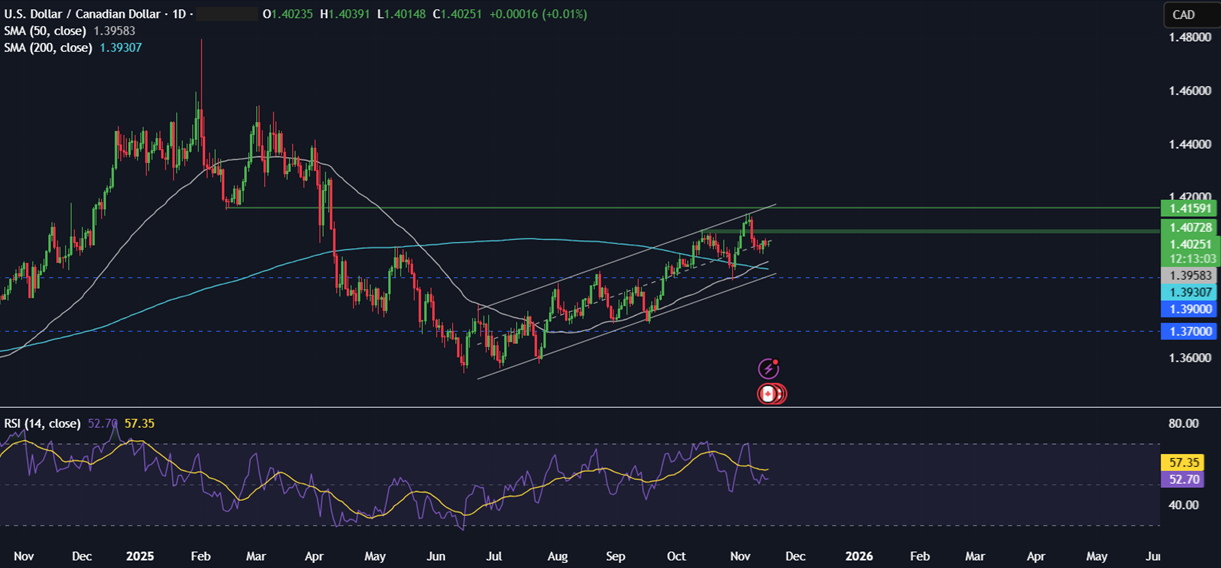
UK CPI (Wednesday)
The most recent Bank of England interest rate decision kept rates unchanged at 4% and the vote was tighter than expected. This decision came as inflation remained unchanged at 3.8% YoY in September, below the expectations of an increase to 4%. This raises expectations that the central bank will cut rates by 25 basis points in December. The data supported the view that CPI may well have peaked, but that doesn’t necessarily mean it will come down quickly, and this is where policymakers differ.
Some policymakers, such as Catherine Mann and Huw Pill, are concerned about persistent inflationary pressures, whilst others can see growing evidence that inflation will start to slow, especially with a deterioration in the jobs market. There are still two more inflation reports between now and the December meeting, so the question is, what will it take to shift Governor Bailey, who has the deciding vote, from a hold to a cut? Coller than expected CPI could do the job and pull GBP/USD lower.
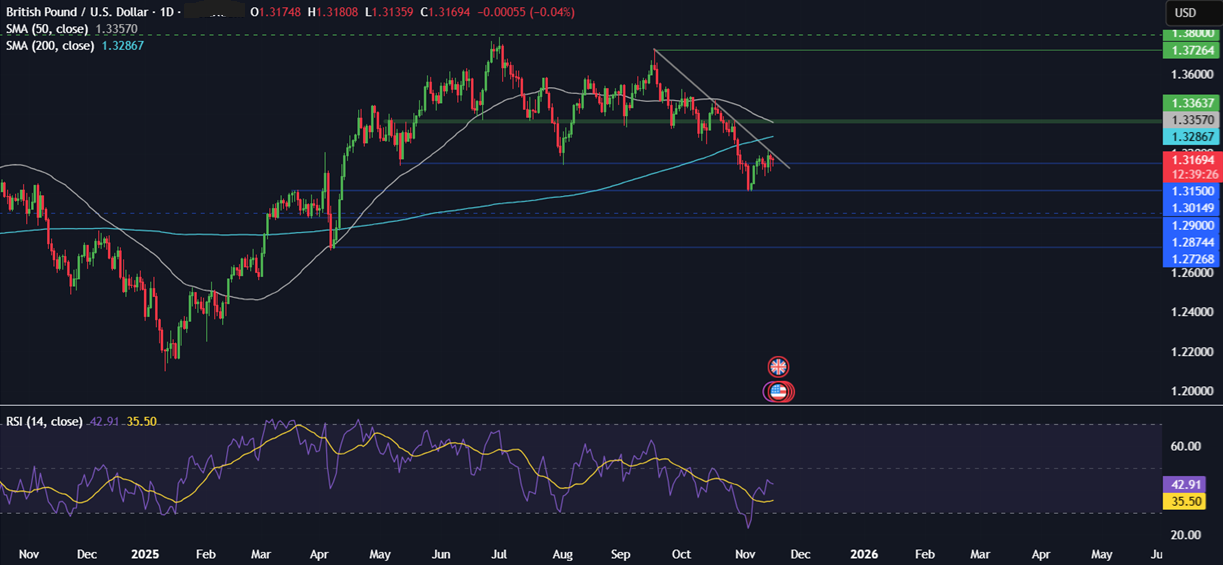
Fed minutes (Wednesday)
As expected, the FOMC cut interest rates by 25 basis points to an upper level of 4% with Trump appointee Stephen Miran voting for a 50 basis point cut, whilst Schmidt voted to leave rates unchanged. The split highlighted the committee’s divergence. The minutes should provide further insight into these divisions, providing more colour over the likelihood of a December rate cut. Following the meeting, Fed chair Powell highlighted the cloudy economic outlook and warned the market against running away with rate cut expectations.
While the US economy has reopened, the Fed continues to fly blind due to the lack of official BLS statistics. The minutes should provide more colour to the potential timing of the next rate cut. The market has lowered rate-cut expectations to 50%. Cautious minutes could pull Gold lower.
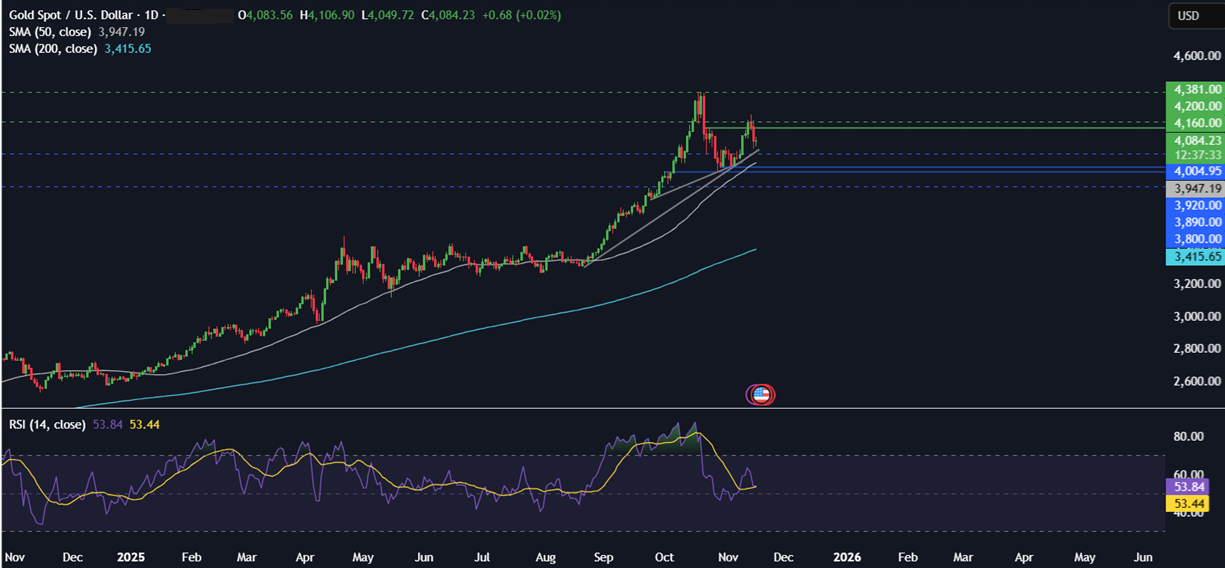
Nvidia Q3 earnings (Wednesday)
Nvidia will release earnings after the close on Wednesday, 19. This is the last of the Magnificent 7 to report and comes at a time when the market needs some reassurance regarding the AI trade (SoftBank sold its entire Nvidia holding last week). However, CEO Jensen Huang also announced that Nvidia had secured $500 billion worth of orders for its Blackwell and next-generation Rubin chips through 2026. In terms of expectations, Q3 EPS is expected at $1.24 on revenue of $54.41 billion. Breaking this down further, the data centre business is expected to post revenue of $48.3 billion. Guidance will also be key, with Q4 profit expected at $1.42 per share and revenue at $60.82 billion.
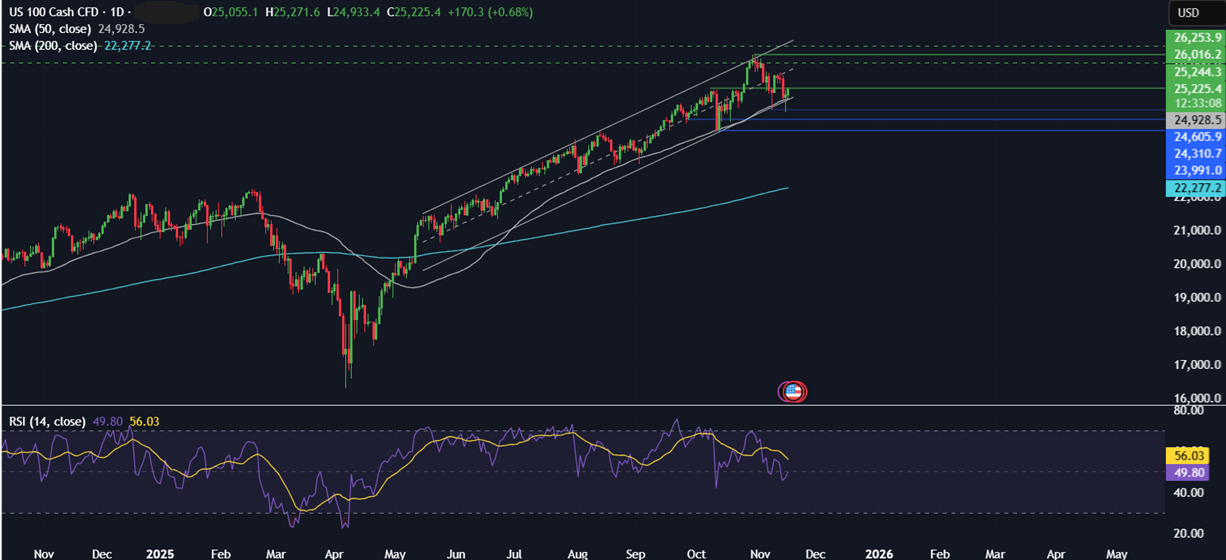
Japanese CPI (Thursday)
Expectations are for core CPI to rise to 3% YoY in October up from 2.9% in September. Price increases are expected to be broad-based, consistent with the Tokyo CPI print. Signs of growth and inflationary pressures could increase the chances of a December BoJ rate hike. Japan’s preliminary Q3 GDP data is due on Monday. The data releases come after the yen fell to an 8-month low against the USD last week, following Prime Minister Sanae Takaichi’s call for the BoJ to be cautious about hiking interest rates and for close policy coordination with the central bank. In order to achieve growth objectives. The PM supports an expansionary fiscal policy, which could further complicate the BoJ’s job. Hotter-than-expected inflation could lift the yen, pulling USD/JPY away from 155.
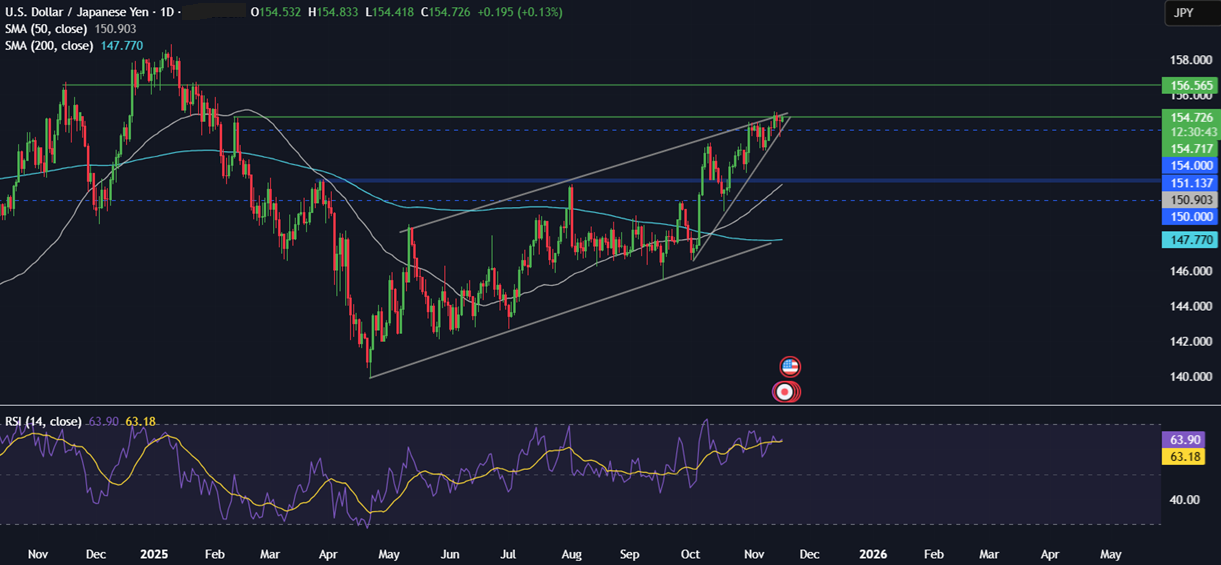
US non-farm payroll report (Thursday)
Following the reopening of the US government, the Bureau of Labor Statistics will release the first backlogged monthly jobs report for September on Thursday, with a flood of other data likely to start flowing soon. The Bureau of Labour Statistics also said a delayed report on inflation-adjusted earnings would come on Friday, 21 November. The numbers will be particularly important given the shaky health of the US labour market, which has become a growing concern, and Fed officials have been divided over whether persistent inflation or a sluggish labour market poses the greater economic threat, clouding the path for interest rates.
The latest monthly jobs report, published on September 5th, showed that employers added 22,000 jobs in August and that the unemployment rate ticked up to 4.3%. The September report was supposed to be released on 3 October. Weak data could support expectations of a Fed rate cut and lift stock indices like the Dow Jones.
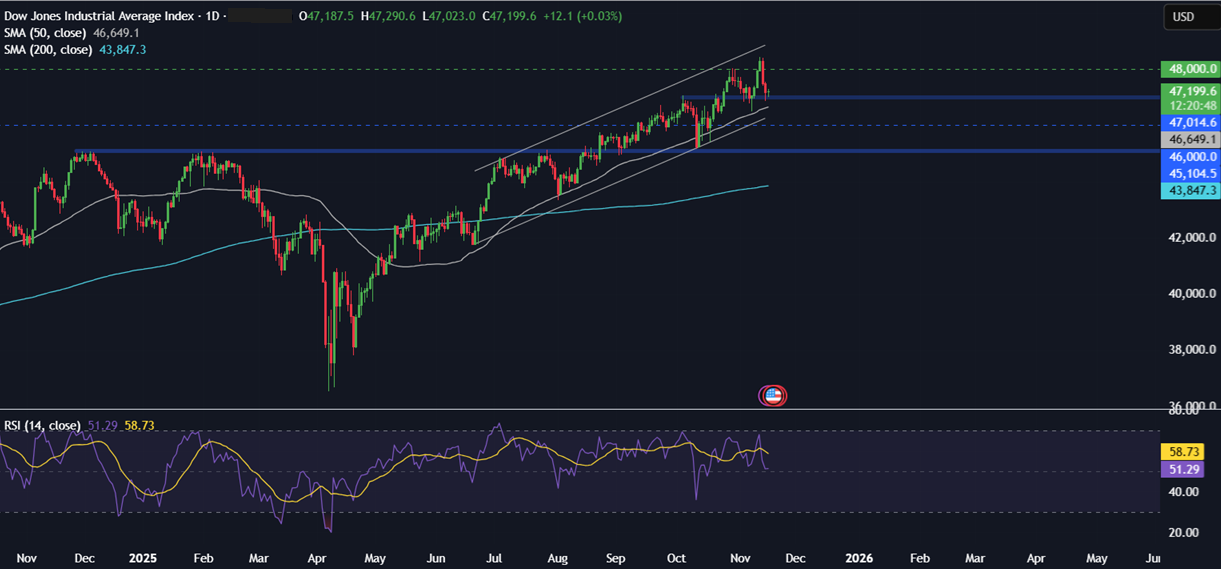
EZ PMIs (Friday)
Recent PMIs have been encouraging, painting a positive picture of the economy in early Q4. The eurozone composite PMI for October was revised higher to 52.5, its highest level in 17 months, as companies received new orders at the fastest rate in 2.5 years, suggesting the bloc’s economy gained momentum at the start of Q4. The service sector drove the improvement, while manufacturing stabilised around 50, the neutral mark. Investors will be watching to see whether this trend continues even with global headwinds, including US protectionism and slowing Chinese growth. Spain remains a notable outperformer, while France and Germany lag. Upbeat data could help EUR/USD rise towards 1.17.

Trading involves risk.
The content provided here is for informational purposes only. It is not intended as personal investment advice and does not constitute a solicitation or invitation to engage in any financial transactions, investments, or related activities. Past performance is not a reliable indicator of future results.
The financial products offered by the Company are complex and come with a high risk of losing money rapidly due to leverage. These products may not be suitable for all investors. Before engaging, you should consider whether you understand how these leveraged products work and whether you can afford the high risk of losing your money.
The Company does not accept clients from the Restricted Jurisdictions as indicated in our website/ T&C. Some services or products may not be available in your jurisdiction.
The applicable legal entity and its respective products and services depend on the client’s country of residence and the entity with which the client has established a contractual relationship during registration.




